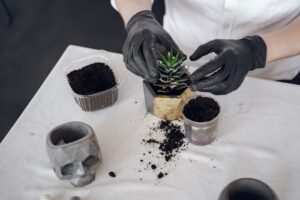Carbon is the primary component of soil organic matter, but can sometimes be overlooked in farming. Understanding carbon’s behavior in soil, how carbon goes through multiple parts of the soil, and what increases soil’s capacity to store carbon for a specific time is crucial to creating an efficient land management practice that will uphold climate integrity and make a meaningful difference in our climate.
The Difference between Soil and Dirt:
Soil includes three different matters and two mediums:
Matter:
- Mineral matter
- Organic matter
- Living matter
Medium:
- Air
- Water
Mineral matter includes the sand silt, rocks, pebbles, and clay that forms the maximum part of the soil. In any agricultural soil, the organic matter must be at least higher than 2% of the topsoil, and living matter – including roots, soil fauna, and micro-organisms must be higher than 0.5% of the upper soil layers. When any soil is mainly dominated by mineral matter, especially the fine mineral phase, it is known as silt or clay soil, or sometimes: dirt. A soil scientist will not use the term dirt, but will use the term “degraded soil” to describe soil that doesn’t have any organic matter or living matter.

The Different Forms of Carbon in Soil:
Soil organic carbon in the USA exists in three different forms. They are:
-
Mineral carbon–
These are carbonates that include calcrete and carbonate nodules.
-
Pyrolysed carbon–
These are also known as black carbon, which combines the natural soots and chars, coke, breeze, clinker, and carbonaceous slag from furnaces and boilers.
-
Organic carbon–
This makes up to 45% of all organic matter
Organic carbon can be sequestered with less energy and less cost than pyrolyzed carbon, and sequestering carbonates takes a long time.
The Three Different Pools of Soil Organic Carbon in the USA:
The three pools of soil organic carbon in the USA include:
- The Labile Pool
- The Semi-Permanent Pool
- The Intractable Pool
The Labile Carbon Pool:
This carbon pool includes simple compounds that are soluble in water or made rapidly soluble by microbes. The labile pool is known as bioavailable carbon since microbes can quickly consume it. The labile pool includes dissolved organic matter (DOM) and compounds readily made soluble by the microbes after 24 hours in moist conditions. This fraction of carbon lasts from hours to a few days unless it is protected.
The Semi-Permanent Pool:
The semi-permanent carbon pool includes readily microbial degradable organic matter that has been subjected to low oxygen transfer and average soil moisture that stimulates the fungal-dominated biome and humification.
When oxygen transfer is high because the oil has low moisture and innumerable macropores, the fraction is mineralized by the bacteria to carbon dioxide and water. The duration of this fraction will depend on whether the conditions favor humidification or mineralization. Considering the conditions, the carbon lasts from weeks to several years in this fraction.
Not only does this pool of soil organic carbon in the USA depend on whether the physical and biological conditions favor humification or mineralization, but also what nutrients are present to play a chemical role. The part of the semi-permanent carbon pool that is degraded or converted to soluble in a few weeks is known as the semi-labile carbon pool. However, this is not considered a separate pool; only a fraction of the semi-permanent is quickly converted to labile.
The Intractable Carbon Pool:
This is the final pool and is defined by the permeance of the nature of the bonding. It includes the following types of compounds.
- Simple organic compounds that can readily degraded, but they are physically entrapped by chunks of clay materials known as domains within the center of micro-aggregates.
- It is chemically tough to break down compounds that include polyaromatic residues that are polyaromatic. These are also difficult for the fungi to access, including the pores of char.
- Soots and small particles of char surrounded by the semi-permanent pool of organic matter. This is highly pyrolyzed carbon and is difficult for the biome to break down, and some persist in the soil for a long time.
All the pools have a two-way movement within them. When humification dominates, the organic matter gets transformed from the labile pool to the semi-permanent pool to the intractable pool, and at equilibrium, the semi-permanent pool dominates till all the charge and divalent cations are covered by organic matter.
To understand a detailed understanding on the soil organic carbon in your soil, it is crucial to get the soil tested. Visit - https://soiloptix.com/ for accurate soil analysis and information.
